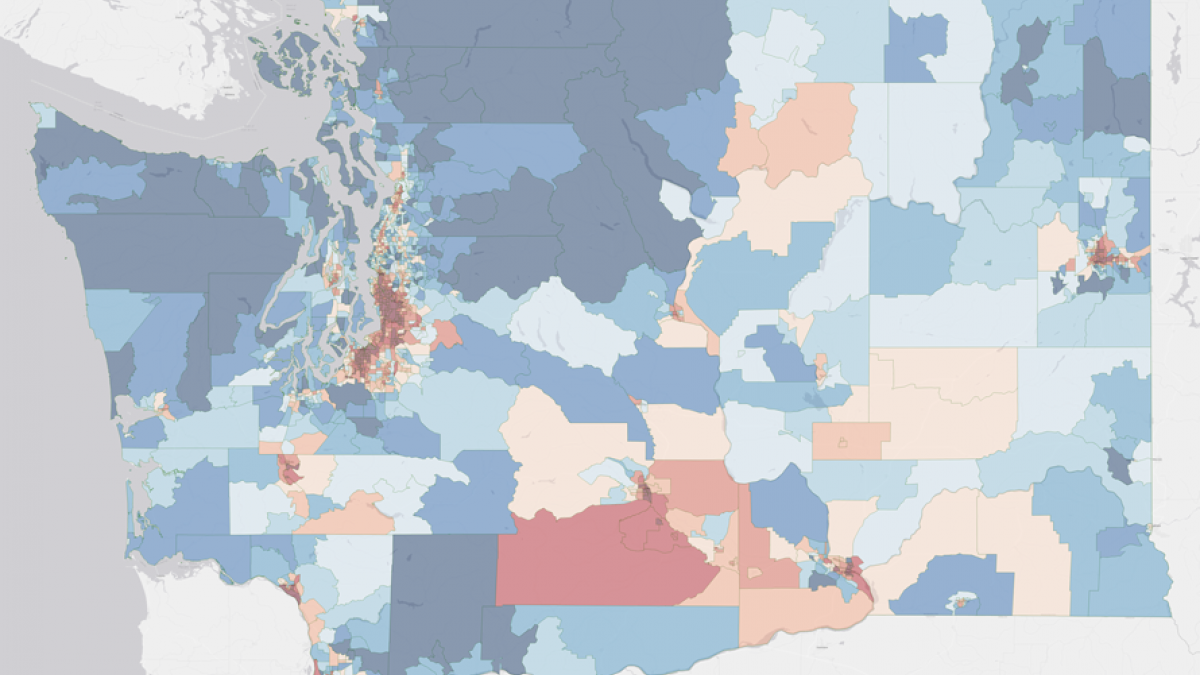
Interactive mapping tool developed by DEOHS and our partners ranks Washington communities most impacted by environmental health risks
The UW Department of Environmental & Occupational Health Sciences (DEOHS) collaborated with partners across Washington to develop an interactive tool that ranks the cumulative risk each neighborhood in Washington faces from environmental factors that influence health outcomes.
The Washington Environmental Health Disparities Map is a free online tool that features customizable map views to pinpoint where living and economic conditions combine with pollution to contribute to inequitable health outcomes and unequal access to healthy communities.
The tool is hosted by the Washington State Department of Health through its Washington Tracking Network. Under the Healthy Environment for All (HEAL) Act, the Department of Health will continue to develop and maintain the map with the most current available information necessary to identify cumulative environmental health impacts and overburdened communities.
The tool is available at: https://fortress.wa.gov/doh/wtn/WTNIBL/. It uses state and national data to map 19 indicators of community health, including exposure to diesel emissions, proximity to hazardous waste facilities, housing affordability and race.
The data are combined into a cumulative score reflecting environmental and socioeconomic risk factors that allows for comparison across Washington’s more than 1,450 US Census tracts.
About the project
 Version 2.0 of the map reflects the cumulative health impacts of environmental risks on communities. The map highlights pollution burden and vulnerabilities to inform state and local environmental policy, budgeting priorities, environmental justice advocacy and regulation enforcement to reduce health inequities across communities.
Version 2.0 of the map reflects the cumulative health impacts of environmental risks on communities. The map highlights pollution burden and vulnerabilities to inform state and local environmental policy, budgeting priorities, environmental justice advocacy and regulation enforcement to reduce health inequities across communities.
Version 1.0 of the map was developed over two years through a process shaped by input from affected communities through a series of 11 statewide “listening sessions.”
Participants included community groups representing communities of color, immigrants, tribes, farmworkers, the elderly and other groups disproportionately impacted by pollution.
Read the full report about the development and methodology of version 2.0 of the mapping tool: DOWNLOAD THE REPORT ❯
Read the full report about version 1.0 of the mapping tool: DOWNLOAD THE REPORT ❯
About the partners
The tool was developed by an innovative, cross-sector collaboration among DEOHS, government agencies and community-based organizations representing disadvantaged and underrepresented populations.
Our partners include:
- Front and Centered, a coalition of community organizations in Washington.
- The Washington State Department of Health.
- The Washington State Department of Ecology.
- The Puget Sound Clean Air Agency.
Publications
In addition to the Methodology Reports above, the project is described in these peer-reviewed publications:
Min, E., Piazza, M., Galaviz, V. E., Saganić, E., Schmeltz, M., Freelander, L., Farquhar, S. A., Karr, C. J., Gruen, D., Banerjee, D., Yost, M., & Seto, E. (2021). Quantifying the Distribution of Environmental Health Threats and Hazards in Washington State Using a Cumulative Environmental Inequality Index. Environmental Justice (Print),14(4), 298–314. https://doi.org/10.1089/env.2021.0021
Min, E., Gruen, D., Banerjee, D., Echeverria, T., Freelander, L., Schmeltz, M., Saganić, E., Piazza, M., Galaviz, V.E., Yost, M., Seto, E.Y.W. (2019) The Washington State Environmental Health Disparities Map: Development of a Community-Responsive Cumulative Impacts Assessment Tool. Int. J. Environ. Res. Public Health, 16(22), 4470. doi:10.3390/ijerph16224470
Contact us
We welcome opportunities to partner with others in continuing to develop the mapping tool. Please contact us: envmap@uw.edu